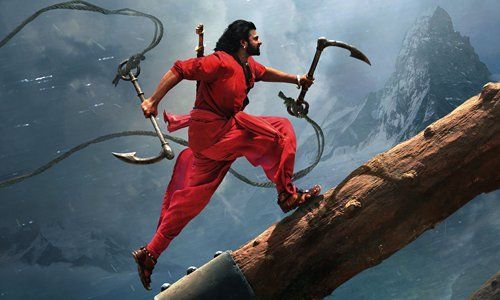Indian film Baahubali 2: The Conclusion, the second half of Indian director S.S. Rajamouli's epic fantasy action film, is set to far outperform part one's performance in the Chinese mainland.

Promotional material for Baahubali 2: The Conclusion (Photo: IC)
Debuting Friday, roughly a year after its debut in its home market of India, The Conclusion has a screen share of 24.6 percent, according to data from Chinese box office tracker Maoyan, the largest screen share of all films premiering this weekend in China.
While it is common for action blockbusters to have a high screen share, it is somewhat surprising considering that Baahubali: The Beginning only was given a screen share of 2.1 percent when it debuted in the mainland in 2016 and its final box office only reached a little more than 7.49 million yuan ($1.17 million).
Turning the tide
Before Baahubali, Rajamouli made a name for himself with 2009's Magadheera and 2012's Eega, both films that featured a large amount of CGI effects. While this CGI trend continued in the Baahubali films, which feature computer generated scenes such as a giant waterfall and the kingdom city of Mahishmati, Rajamouli told the Global Times in an email interview that he in fact is not "a fan of VFX."
"VFX is another tool like background score or lighting which enhances the cinematic narrative," the director said, adding that it was to "enhance and create a larger than life canvas" in the case of Baahubali.
Baahubali: The Beginning received a score of 7.2/10 from 20,308 viewers on Chinese media review platform Douban.
While a few netizens expressed that they had a hard time suspending their disbelief when it came to the feats achieved by the "almighty" hero in the film, many praised the film for being a "qualified" work that Chinese filmmakers should take the time to learn from.
Despite the above average score, The Beginning was one of poorest earning Indian films to release in Chinese in recent years.
"I have discussed [this] with my producer and our Chinese distributor as well. I understand that we could not get enough shows for the film and this was because in the last minute another big film was scheduled on the same day and most shows were allotted to that film," Rajamouli said concerning the first Baahubali film's performance in the Chinese mainland.
"In the first part of the film, we cut from present to past through a flashback and end the film on a cliffhanger. The same actor plays both the father and son which is normal in Indian cinema but not common in other countries. Hence some of the audience could have felt lost," he added, explaining that since part two "concludes the film and answers the cliffhanger question," he believes audience will enjoy it better.
Judging by reviews from Chinese that saw the film overseas when it debuted in April 2017, things are looking up.
"This is what an epic blockbuster should be. Sparing no expense to make the city, special effects were used in just the right way. The war scenes were exciting," netizen Kooperl posted on Douban, going on to note that the film "was over exaggerated and had too much slow motion" which he admitted was a trend in "Indian style cinema."
"The exaggerated nature of the film almost made me laugh out loud! And then they start dancing when you least expect it... but the cinematography is beautiful," netizen Yibanlian posted on Sina Weibo.
Beneficial trend
Indian films have been experiencing something of a renaissance in the Chinese market of late. In 2017, sports film Dangal earned a whopping 1.29 billion yuan in the Chinese mainland, while this year Secret Superstar and Bajrangi Bhaijaan pulled in 747 million yuan and 286 million yuan respectively.
"A more important reason [for the low box office] is that in 2016, the film market in the Chinese mainland was experiencing a low tide," Tan Zhen, a research fellow at the China Federation of Literary and Art Circle's Film Art Centre, told the Global Times.
"The film was an unknown quantity for Chinese filmgoers back then, and didn't star any recognizable stars."
Tan noted that the recent success of Indian film in China has caused Chinese audiences to pay more attention to these films, a situation that can only help Baahubali 2: The Conclusion.
"Chinese filmmakers began to reassess the potential of Indian films, and strategies to break into the Chinese market became hot in Bollywood," Tan wrote in magazine China-India Dialogue.
However, on the other side, Chinese films have not been able to strike a cord in India and Sino-India cooperation projects have not seen any success stories in India.
"First, the story should be set both in India and China and needs both Chinese and Indian actors... Apart from that, when it comes to technical prowess each country has its individual strengths which can and should be evaluated in relation to the project and the strengths of each country should be chosen," Rajamouli said, adding that this is the way "we can make a great product that can be enjoyed by both countries."


